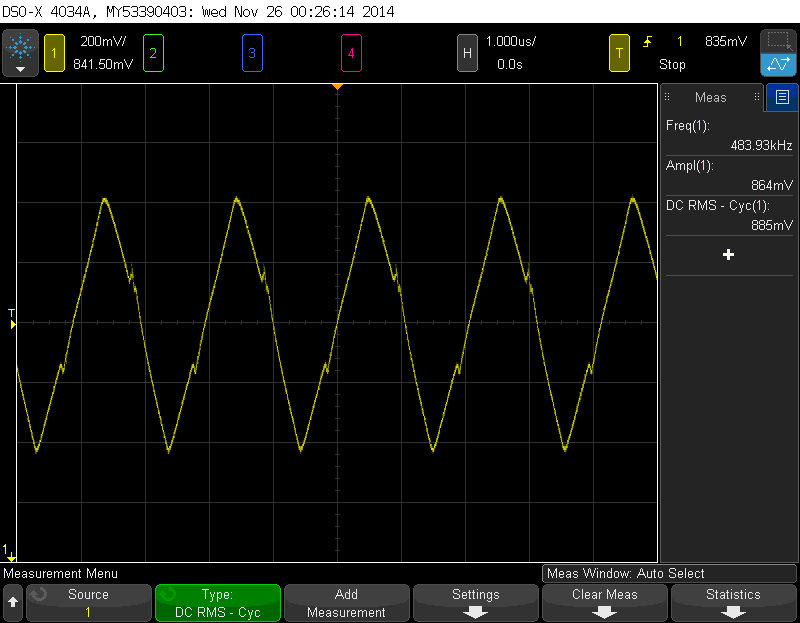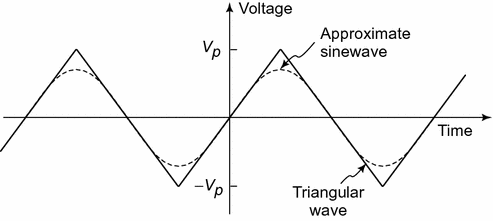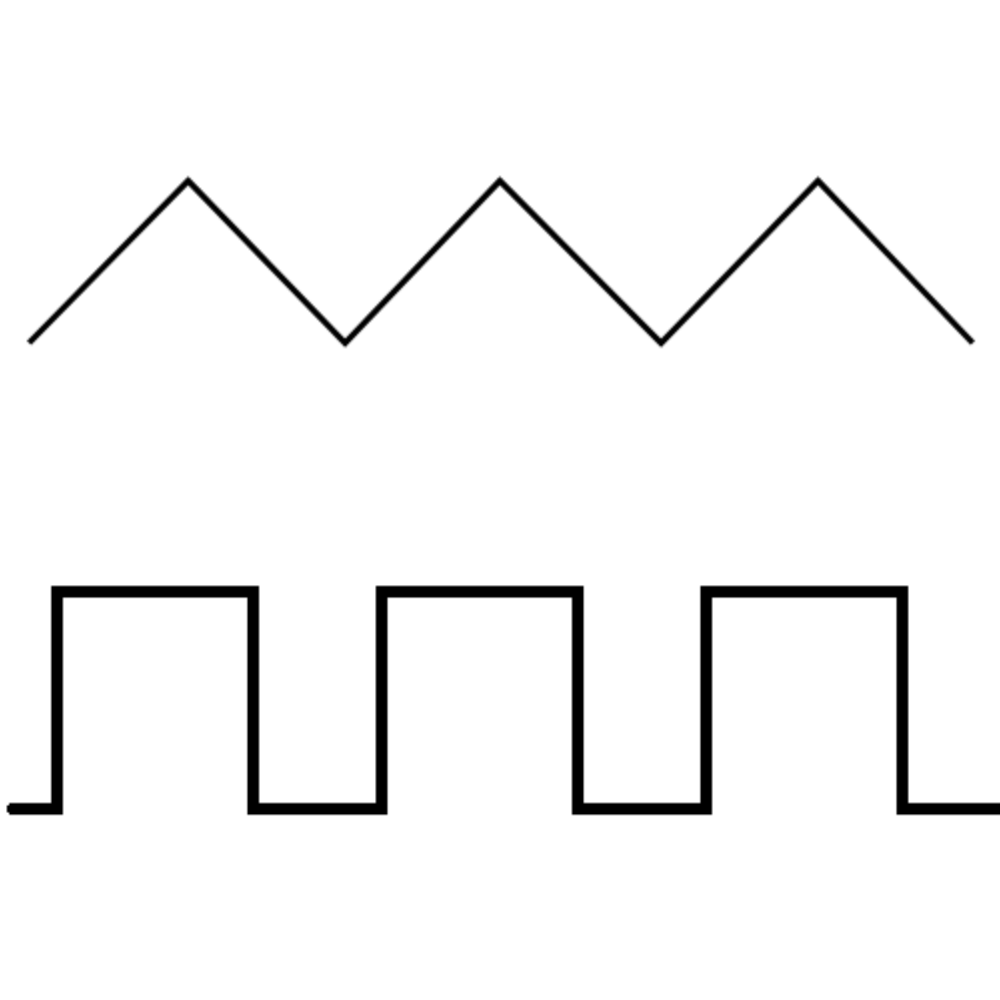Triangular Waveform
Triangular waveforms are a basic concept in electronics and signal processing, known for their straight-line rise and fall, balanced shape, and sharp peaks. Unlike other waveforms like sine or square waves, triangular waveforms have special features that make them especially useful in various tasks, from creating music to designing electronic circuits. This article explores the characteristics, how they are made, and where they are used, providing a clear understanding of why this particular waveform is commonly used in both technical and creative fields.Catalog

Figure 1: Triangular Waveform Display on an Oscilloscope
Understanding the Structure of Triangular Waveforms
A triangular waveform is a type of signal often used in electronics and signal processing. It has a shape that rises and falls in straight lines, creating a series of sharp, pointed peaks. This waveform has a few main features that make it different from other types of waveforms. Let's explore these features in simple terms.
Linear Rise and Fall
One of the most noticeable things about a triangular waveform is how it moves up and down in a straight line. Unlike waveforms like sine waves, which have smooth and curved transitions, a triangular waveform has a straight, even slope as it rises to its peak and then falls back down. This means that the increase and decrease in voltage (or current) happen at a steady, unchanging rate. Because of this, the waveform looks sharp and angular, with pointy peaks instead of rounded ones.
Symmetry
A triangular waveform usually has a balanced shape, meaning it takes the same amount of time to rise from the lowest point to the highest point as it does to fall back down again. This balance creates what’s known as a 50% duty cycle, which means the waveform spends an equal amount of time going up as it does coming down. This evenness is helpful in situations where you need a waveform that behaves in a consistent and predictable way, such as in creating sound waves or controlling the timing in electronic circuits.
Frequency
The frequency of a triangular waveform is how often the waveform repeats itself in one second. You can think of a full cycle as starting from the lowest point, rising to the highest point, and then falling back to the lowest point again. Frequency is measured in Hertz (Hz), where one Hertz equals one complete cycle per second. If the frequency is higher, the waveform repeats more quickly, leading to a pattern with more peaks and valleys in a shorter amount of time. This can affect how the waveform works in electronic circuits, especially in things like audio synthesis, where controlling the frequency is important for getting the right sound.
Amplitude
Amplitude is the height of the triangular waveform, measured from the middle line (called the zero line) to the peak. This peak is the highest point the waveform reaches, and it represents the maximum voltage or current the waveform can produce. The amplitude is a measure of how strong or powerful the waveform is, and it affects the energy it carries. In things like signal processing, the amplitude of a triangular waveform can determine how much power the signal has and how effectively it can drive electronic components or systems.
Symmetrical vs. Non-Symmetrical Triangular Waveforms
Triangular waveforms are shapes in which the signal rises and falls in a straight, even manner. Usually, these waveforms are symmetrical, meaning the time it takes for the signal to go up is the same as the time it takes to come down. This creates a balanced shape, where both sides of the waveform are mirror images of each other.
However, triangular waveforms can also be non-symmetrical, where the times for rising and falling are different. In these cases, one side of the waveform may go up or down faster than the other, leading to an uneven shape. If the difference between the rise and fall times is large, the waveform may start to look like a sawtooth pattern, with one side being much steeper than the other.
The difference between symmetrical and non-symmetrical triangular waveforms is useful in situations where the timing of how the signal changes needs to be controlled in a specific way. This allows for adjusting the shape of the waveform to match particular needs in various applications.
Generating Triangular Waveforms

Figure 2: Circuit Diagram for Generating Triangular Waveform
Creating a triangular waveform is done using a simple electronic circuit called an integrator, which usually includes an operational amplifier, or op-amp. The process starts with a square wave, which is a type of signal that quickly shifts between high and low voltage levels. The integrator circuit then transforms this square wave into a triangular waveform.
First, a square wave with a certain frequency (how often it repeats) and amplitude (the height or strength of the voltage) is used as the starting signal. The integrator reacts to this square wave by producing a ramp-like output. When the square wave is at a high voltage level, the integrator’s output gradually increases. When the square wave drops to a low voltage level, the output gradually decreases.
The integrator's job is to change the square wave into a triangular waveform. The speed at which the triangular waveform rises and falls depends on the amplitude of the input square wave and the specific design of the integrator circuit, including the values of the resistors and capacitors used.
The triangular waveform has the same frequency as the square wave that was fed into the circuit, but its height and steepness are influenced by the input signal and how the integrator is set up. This technique is useful in electronic signal processing because it allows for the creation of waveforms that can be adjusted for different purposes, such as in waveform generators and audio synthesis, making sure they work smoothly with other signals in a system.
Mathematical Representation of Triangular Waveforms
The triangular waveform is a type of signal often used in electronics and signal processing. It can be described using a mathematical method called a Fourier series, which breaks the waveform down into a sum of sine waves. Each of these sine waves represents a different frequency, known as a harmonic.
The formula for a triangular waveform is:
![]()
Let's go through what each part of this formula means:
![]() represents the triangular waveform as it changes over time ttt.
represents the triangular waveform as it changes over time ttt.
![]() shows that the series is a sum that starts with
shows that the series is a sum that starts with ![]() and goes on without end. This continuous sum helps us closely match the shape of the triangular waveform.
and goes on without end. This continuous sum helps us closely match the shape of the triangular waveform.
![]() flips the sign for each term in the series. This flip is needed to make sure each harmonic wave aligns correctly to form the triangular shape.
flips the sign for each term in the series. This flip is needed to make sure each harmonic wave aligns correctly to form the triangular shape.
![]() points out which harmonic we're dealing with. Only the odd-numbered harmonics (1st, 3rd, 5th, etc.) are included in the waveform. This means for
points out which harmonic we're dealing with. Only the odd-numbered harmonics (1st, 3rd, 5th, etc.) are included in the waveform. This means for ![]() , the first harmonic (the main frequency) is included; for
, the first harmonic (the main frequency) is included; for ![]() , the third harmonic is added, and so on.
, the third harmonic is added, and so on.
![]() tells us how big each harmonic wave is. The size of each harmonic wave gets smaller as the harmonic number goes up. This shrinking effect makes the triangular waveform smoother and more gradual than a square wave.
tells us how big each harmonic wave is. The size of each harmonic wave gets smaller as the harmonic number goes up. This shrinking effect makes the triangular waveform smoother and more gradual than a square wave.
![]() is the sine wave for each harmonic, where f is the main frequency of the waveform.
is the sine wave for each harmonic, where f is the main frequency of the waveform.
The triangular waveform is built from these odd-numbered harmonics, with each harmonic getting smaller as the harmonic number increases. This specific setup of harmonics and their sizes gives the triangular waveform its steady rise and fall, setting it apart from other types of waveforms like square waves or sawtooth waves, which have different harmonic patterns.
Conversion of Triangular Wave to Sine Waves

Figure 3: Conversion of Triangular Wave to Sine Wave
A triangular waveform can be changed into a sine wave by using a process that softens its sharp edges. This is done by sending the triangular waveform through a special circuit made up of diodes and resistors. Diodes are electronic components that allow electricity to flow in one direction, while resistors limit the flow of electrical current. When the triangular waveform goes through this circuit, the diodes smooth out the sharp peaks and valleys, making them more rounded. The resistors help to further smooth out the waveform, turning the straight lines of the triangular wave into the curved shape of a sine wave. This results in a waveform that looks much more like the smooth, continuous curve of a sine wave, which is often needed in many types of electronic equipment where smooth signals are better.
Distinguishing Triangular Waveforms from Other Waveforms
Triangular waveforms have a unique shape that makes them stand out from other common waveforms like sine waves and square waves. Understanding these differences can help you recognize and use these waveforms more effectively in various applications, such as signal processing and electronics.
Triangular Waves vs. Sine Waves

Figure 4: Sine Wave and Triangular Wave
Sine waves are well-known for their smooth, flowing curves that rise and fall in a gentle, continuous motion. The slope, or the steepness of the curve, changes gradually throughout the waveform, giving it a rounded appearance. On the other hand, triangular waves behave differently. Instead of curving smoothly, a triangular wave has straight, slanted lines that rise and fall at a steady rate. These straight lines create sharp, pointed peaks, making the waveform look more angular and less rounded than a sine wave. The way triangular waves rise and fall in a straight line, rather than a curve, makes them easy to spot compared to the flowing shape of a sine wave.
Triangular Waves vs. Square Waves

Figure 5: Triangular Waves vs. Square Waves
Square waves are easily recognized by their sharp, sudden jumps between high and low levels, creating a box-like appearance. In a square wave, the change from the highest point to the lowest happens instantly, without any gradual transition. Triangular waves, however, move between high and low levels in a much smoother way. Instead of jumping instantly from one level to another, a triangular wave rises and falls at a steady, slanted rate, giving it a more gradual slope. This makes the triangular wave look more like a series of ramps or inclined planes, rather than the sharp edges of a square wave. The steady rise and fall of a triangular wave give it a much more slanted and less abrupt appearance than the straight edges of a square wave.
Practical Applications of Triangular Waves

Figure 6: Triangular Waveform in Signal Processing and Music Applications
Triangular waveforms are commonly used in both technical and creative areas because of their simple shape and special sound qualities. In signal processing, these waveforms are often used in devices that generate signals for testing and calibration. Their steady rise and fall makes them easy to measure and analyze, which is why they are preferred for such tasks. In music, especially with synthesizers, triangular waveforms are liked for their softer sound compared to square waves. This softer sound comes from the fact that triangular waveforms only include odd harmonics (specific sound frequencies), and these harmonics quickly fade, creating a smoother tone. Triangular waveforms are also useful in oscilloscope testing, where their clear and steady transitions make them easy to read and reliable for checking and adjusting equipment. These practical uses in different fields show how versatile and helpful triangular waveforms are, whether in technical or creative settings.
Conclusion
To sum up, triangular waveforms stand out because of their straight-line rise and fall, balanced shape, and unique way of combining different frequencies. These qualities make them versatile and useful in many different areas. Whether used in signal processing, music creation, or testing electronic equipment, the steady and predictable nature of triangular waveforms makes them a common choice in many situations. By learning how these waveforms are created and applied, you can better appreciate their role in various technologies and creative projects.
Frequently Asked Questions [FAQ]
1. What is the mean value of a triangular wave?
The mean value of a triangular wave is zero when the wave is balanced around the center line (the horizontal axis). This happens because the positive and negative parts of the waveform cancel each other out over one full cycle.
2. How do you differentiate a triangular wave?
When you differentiate a triangular wave with respect to time, you get a square wave. The triangular wave’s steady rise and fall changes into the square wave's sudden jumps between high and low levels.
3. How to generate a triangular wave?
You can generate a triangular wave by using a simple electronic circuit called an integrator, which usually includes an operational amplifier (op-amp). First, you start with a square wave, and the integrator then changes this square wave into a triangular waveform by slowly increasing and decreasing the output voltage.
4. What are the applications of a triangle wave?
Triangular waves are used in different areas, such as creating music tones that are softer than other waveforms, testing and adjusting electronic devices because their shape is easy to work with, and in communication systems where they help with certain modulation techniques.
5. What is the description of a waveform?
A waveform is a picture or graph that shows how a signal changes over time. It displays the shape, height (amplitude), frequency (how often it repeats), and phase (timing) of the signal, giving a clear view of how the signal behaves.